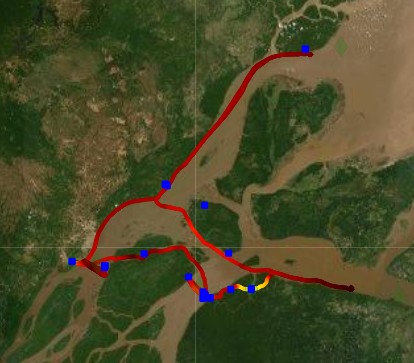TROCAS Project
Contents
TROCAS Project¶
Project description¶
The main stem of the Amazon River is a large supplier of carbon dioxide (CO2) to the atmosphere, most of which is sourced as organic carbon from the surrounding landscape and subsequently remineralized in river. The component of the river system that is least well understood is the tidal reach, which consists of two main channels each three times the girth of the Mississippi River at its widest point. While tidal forcing does not result in salt intrusion, riverine flow in this reach can be reversed, and complex interactions occur between the river channels and the fringe areas, making the study of this component of the world’s largest river a significant logistical challenge. In recognition of earlier work demonstrating that pCO2 and outgassing remains very elevated in the lower Amazon River, we previously evaluated the respective components of Net Ecosystem Exchange (NEE) from Óbidos downriver to Macapá over four cruises, focusing on how metabolic processes apparently drive the elevated pCO2 and subsequent outgassing, relative to advective fluxes. Two pilot cruises were made from Macapá down to the actual river mouth, evaluating the seaward propagation of the pCO2 signal. Preliminary measurements that fluxes of CO2 to the atmosphere remain high out to the freshwater terminus located ~60km offshore from the river mouth.
Aside from these initial surveys, no systematic measurements have ever been made in the lower reach out into the plume. Considering the vast amount of surface area this region encompasses, its evaluation will significantly increase global estimates of aquatic CO2 outgassing and help complete global carbon flux estimates. Likewise, there is little mechanistic understanding of the biological and physiochemical processes that control carbon cycling in this transition zone. The overall research objective of TROCAS (Trocas Líquidas de Carbono do Ecossistema do Baixo Rio Amazonas: Da Terra para o Oceano e Atmosfera; Net Ecosystem Exchange of the Lower Amazon: from Land to the Ocean and Atmosphere) is to examine, at different scales, the processes that govern the advection and reaction of carbon in the lowest reach of the Amazon River and along the near-shore coastline of the tropical North Atlantic Ocean. Two primary questions are being addressed:
What are the geographic and temporal distributions and magnitudes of riverine CO2 production (system-scale)
What are the dynamics that drive and control outgassing (microbial-scale)?
To evaluate these questions, tools from detailed chemical analysis to proteomics, continuous underway recordings, remote sensing data and hydrology. The goals of this website are to describe the datasets being generated; provide access to scientific results, data browsing and data processing tools; and present a broader vision of the overall project and its team members.
Funding¶
TROCAS is funded by the Fundação de Amparo à Pesquisa do Estado de São Paulo (FAPESP, the science-funding organization of the State of São Paulo), through their “São Paulo Excellence Chair (SPEC)” thematic program, and the Universidade de São Paulo, and by the NSF Ecosystem Studies program (NSF Award 1754317: Biogeochemical Processes along the Lower Amazon River Continuum).
